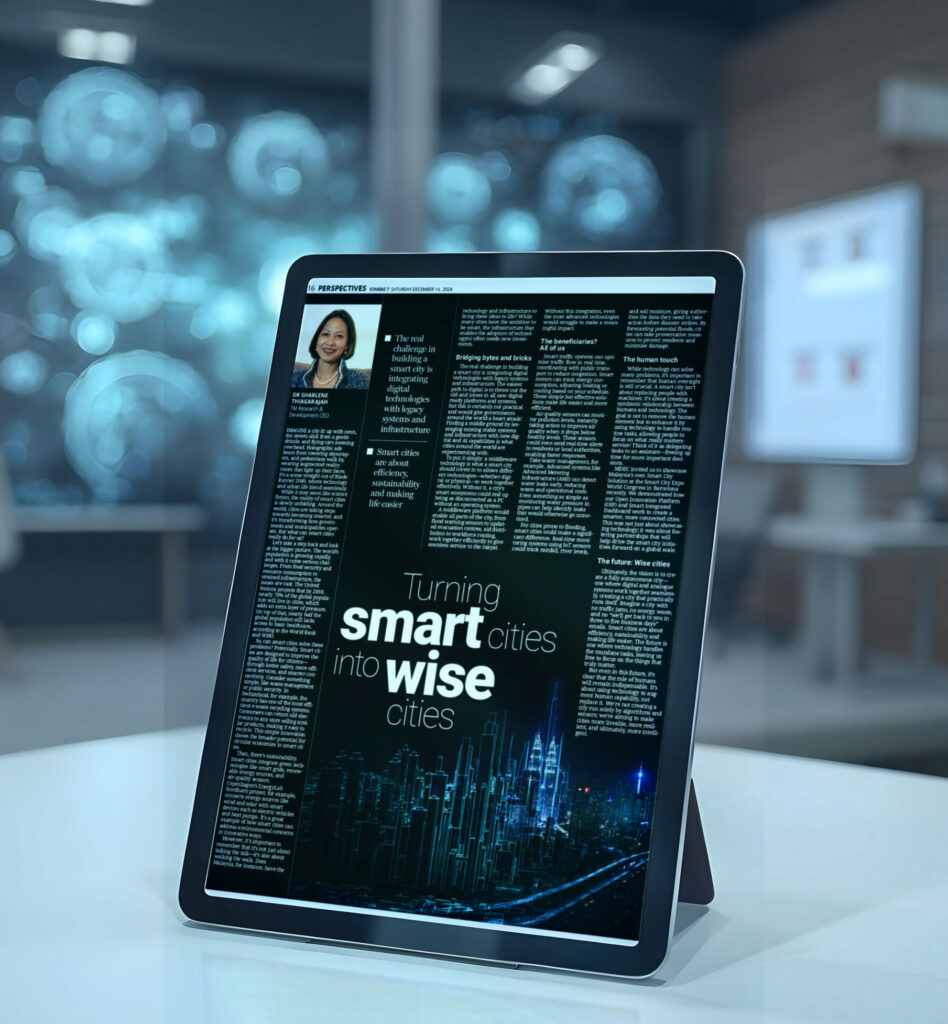IMAGINE a city lit up with neon, the streets slick from a gentle drizzle, and flying cars zooming overhead. Holographic ads beam from towering skyscrapers, and pedestrians walk by, wearing augmented reality visors that light up their faces. It’s a scene straight out of Blade Runner 2049, where technology and urban life blend seamlessly.
While it may seem like science fiction, the reality of smart cities is slowly unfolding. Around the world, cities are taking steps toward becoming smarter, and it’s transforming how governments and municipalities operate. But what can smart cities really do for us?
Let’s take a step back and look at the bigger picture. The world’s population is growing rapidly, and with it come serious challenges. From food security and resource consumption to strained infrastructure, the issues are vast. The United Nations projects that by 2050, nearly 70% of the global population will live in cities, which adds an extra layer of pressure. On top of that, nearly half the global population still lacks access to basic healthcare, according to the World Bank and WHO.
So, can smart cities solve these problems? Potentially. Smart cities are designed to improve the quality of life for citizens—through better safety, more efficient services, and smarter connectivity. Consider something simple, like waste management or public security. In Switzerland, for example, the country has one of the most efficient e-waste recycling systems. Consumers can return old electronics to any store selling similar products, making it easy to recycle. This simple innovation shows the broader potential for circular economies in smart cities.
Then, there’s sustainability. Smart cities integrate green technologies like smart grids, renewable energy sources, and air-quality sensors. Copenhagen’s EnergyLab Nordhavn project, for example, connects energy sources like wind and solar with smart devices such as electric vehicles and heat pumps. It’s a great example of how smart cities can address environmental concerns in innovative ways.
However, it’s important to remember that it’s not just about talking the talk—it’s also about walking the walk. Does Malaysia, for instance, have the technology and infrastructure to bring these ideas to life? While many cities have the ambition to be smart, the infrastructure that enables the adoption of technology(s) often needs new investments.
Bridging bytes and bricks
The real challenge in building a smart city is integrating digital technologies with legacy systems and infrastructure. The easiest path to digital is to throw out the old and invest in all new digital ready platforms and systems, but this is certainly not practical and would give governments around the world a heart attack! Finding a middle ground by leveraging existing stable systems and infrastructure with new digital and AI capabilities is what cities around the world are experimenting with.
To put it simply: a middleware technology is what a smart city should invest in to allows different technologies—whether digital or physical—to work together effectively. Without it, a city’s smart ecosystems could end up being as disconnected as a PC without an operating system.
A middleware platform would enable all parts of the city, from flood warning sensors to updated evacuation centres, aid distribution to workforce routing, work together efficiently to give seamless service to the rakyat. Without this integration, even the most advanced technologies would struggle to make a meaningful impact.
The beneficiaries? All of us
Smart traffic systems can optimise traffic flow in real time, coordinating with public transport to reduce congestion. Smart meters can track energy consumption, adjusting heating or cooling based on your schedule. These simple but effective solutions make life easier and more efficient.
Air quality sensors can monitor pollution levels, instantly taking action to improve air quality when it drops below healthy levels. These sensors could even send real-time alerts to residents or local authorities, enabling faster responses.
Take water management, for example. Advanced systems like Advanced Metering Infrastructure (AMI) can detect water leaks early, reducing waste and operational costs. Even something as simple as monitoring water pressure in pipes can help identify leaks that would otherwise go unnoticed.
For cities prone to flooding, smart cities could make a significant difference. Real-time monitoring systems using IoT sensors could track rainfall, river levels, and soil moisture, giving authorities the data they need to take action before disaster strikes. By forecasting potential floods, cities can take preventative measures to protect residents and minimise damage.
The human touch
While technology can solve many problems, it’s important to remember that human oversight is still crucial. A smart city isn’t about replacing people with machines; it’s about creating a symbiotic relationship between humans and technology. The goal is not to remove the human element but to enhance it by using technology to handle routine tasks, allowing people to focus on what really matters- service! Think of it as delegating tasks to an assistant—freeing up time for more important decisions.
MDEC invited us to showcase Malaysia’s own Smart City Solution at the Smart City Expo World Congress in Barcelona recently. We demonstrated how our Open Innovation Platform (OIP) and Smart Integrated Dashboard work to create a smarter, more connected cities. This was not just about showcasing technology; it was about fostering partnerships that will help drive the smart city initiatives forward on a global scale.
The future: Wise cities
Ultimately, the vision is to create a fully autonomous city—one where digital and analogue systems work together seamlessly, creating a city that practically runs itself. Imagine a city with no traffic jams, no energy waste, and no “we’ll get back to you in three to five business days” emails. Smart cities are about efficiency, sustainability, and making life easier. The future is one where technology handles the mundane tasks, leaving us free to focus on the things that truly matter.
But even in this future, it’s clear that the role of humans will remain indispensable. It’s about using technology to augment human capability, not replace it. We’re not creating a city run solely by algorithms and sensors; we’re aiming to make cities more liveable, more resilient, and, more intelligent.
This article was first published in the StarBiz 7, Issue Nov 14 2024: Bullish or bearish?
To access the PDF version, Click Here
To read the full Star epaper, Click Here


